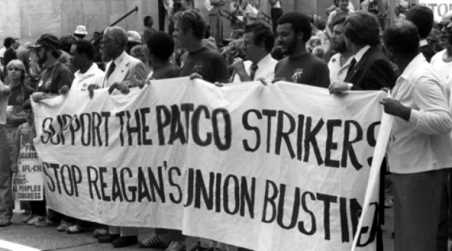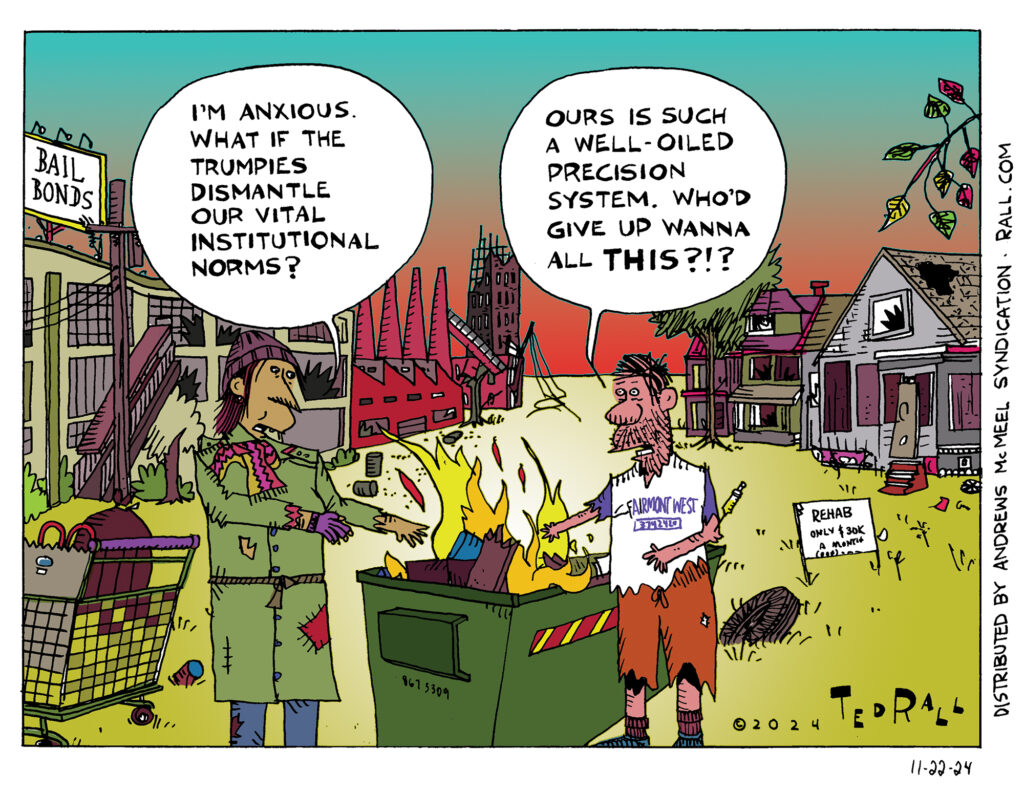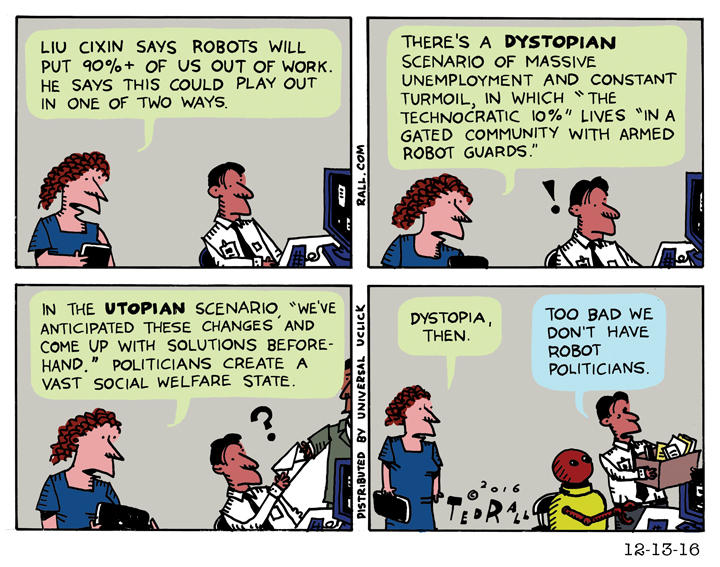One of the assumptions of Kamala Harris’s failed presidential bid was that voters didn’t want radical change of any kind. She promised an incremental approach designed to gradually improve things without altering what she assumed were beloved American institutions like the courts. In reality, life for most Americans is pretty bleak and they don’t have much investment in those longstanding traditions.
Trump, the UAW and the Next Realignment

Bipartisanship is dead. But job-killing trade agreements like NAFTA were promoted by politicians of both major parties alike—until Donald Trump. “Our politicians have aggressively pursued a policy of globalization, moving our jobs, our wealth and our factories to Mexico and overseas. Globalization has made the financial elite, who donate to politicians, very, very wealthy. I used to be one of them,” he told an audience in Pennsylvania in 2016. “Many of these areas have never recovered and never will unless I become president. Then, they’re going to recover fast.”
They didn’t. The Rust Belt continues to disintegrate.
Trump didn’t deliver. But his message proved to be an effective vote generator. It turned Ohio, the ultimate bellwether swing state, red. Formerly Democratic Pennsylvania now swings. So it’s no surprise that Trump is repeating his message to workers: deindustrialization sucks, no one sees your pain but me, and I’ll make it go away.
This year, Dr. Trump is going even further than any previous Republican president has gone before, reaching out to big labor, long a bête noire for Republicans. September 27th finds the once-and-possibly-future president skipping the second GOP presidential debate and speaking instead to striking autoworkers.
Symbolically, Trump’s outreach represents a radical contrast for a party with a long and consistent history of antagonism to workers’ right to bargain collectively. Congressional Republicans rammed through the Taft-Hartley Act, Reagan fired the air traffic controllers, Republican-controlled legislators created union-gutting “right to work” states and, as a result, union campaign contributions overwhelmingly flowed to Democratic candidates. This is the first time in memory—possibly ever—that a major Republican presidential contender has thought of campaigning to union members, during a walkout no less.
Meanwhile “Union Joe” Biden, who likes to emphasize his working-class Scranton background and has collected numerous union endorsements, has been publicly silent about the UAW strike—a stance made starker when he jammed a contract down the throats of freight train workers when they threatened to walk off the job. The President hasn’t expressed any desire to meet with striking workers, whether at one of the big three automakers, the SAG-AFTRA writers in Hollywood, or Amazon warehouses. Biden’s support for unions has been performative and rhetorical.
What about Trump’s?
At this date, Trump is the better talker. Nothing new here, when compared to Biden. The question is, might the Republican Party assume policy positions that credibly allow it to argue that it has become an ally of workers, after decades of being their enemy in service of their corporate masters?
If anyone can and will spearhead such a pivot, it will be Trump, the man who pulled off the neat trick of running against the Iraq War in the den of bloodthirsty militarism that is a Republican primary, and winning, and going on to become the first president in two decades to seriously negotiate with the Taliban, signing a deal to withdraw from Afghanistan, yet remaining a hero of the right.
Should Trump construct a pro-labor Republicanism, we may be at the dawn of the biggest political realignment election since 1932. Roosevelt’s victory at the depth of the Great Depression and the subsequent enactment of his New Deal reversed the basic duopolistic structure in place since 1860. For three-quarters of a century the Party of Lincoln had represented progressivism and the struggle for equal rights while Democrats had embraced reactionary and racist policies with the occasional interruption of white-aligned populists like William Jennings Bryan; in rough terms, the parties switched places as Democrats embraced liberalism as we know it and Republicans took on conservatism.
We are currently experiencing a realignment-in-waiting, a 1932-scale ideological reversal that is taking hold in some arenas, tentative in others and will live or die depending on what party leaders do about two or three key issue categories.
On foreign policy, realignment is nearly complete. America’s current project in interventionism, the proxy war in Ukraine, enjoys full-throated support from Biden and Congressional Democrats while the antiwar voices are found not in the supposedly democratic-socialist “Squad” but the far-right Freedom Caucus. Culturally, the Democratic Party has become the home of well-educated coastal elites while the GOP increasingly draws in voters with high school educations and lower incomes in flyover country.
Realignment remains stillborn without an analogous reversal in domestic affairs, however. This is where Republicans have yet to demonstrate an appetite to reverse course.
A 180° switcheroo would see a genuine attempt by Republicans to address long-standing economic problems that traditionally have been Democratic Party projects if and when they have been discussed at all: soaring healthcare costs, high college tuition, poverty, homelessness, unaffordable housing, low real wages. In Alcoholics Anonymous the first step is admitting you have a problem; in politics the first step is talking about a problem in a way that shows that you acknowledge its existence. Some Republicans are finally starting to address some of these issues. But that’s a far cry from proposing meaningful solutions, much less legislation.
Trump’s hostile takeover of the Republican Party put him on a collision course with the neoconservatives who started two forever wars. He prevailed in that fight. Should Trump choose to chart a path for Republicans that includes an appeal to ordinary workers, he will have to defeat the traditional Republicans who created the status quo like rival presidential candidate Senator Tim Scott of South Carolina, who suggests that the appropriate response to striking auto workers is to replicate the way Reagan handled PATCO: “He said, you strike, you’re fired. Simple concept to me to the extent that we can use that once again.” Similarly, Governor Brian Kemp dismisses the UAW as a blue-state nuisance: “We just haven’t been dealing with it in Georgia, because we’re a right-to-work state.”
Trump’s outreach to labor could, and most likely will prove to be, nothing more than an empty gesture designed to extract votes ahead of an election, no follow up forthcoming, no actual leaning on management to cough up higher wages and better conditions for workers. Or it might be the beginning of something big, like his America First foreign policy, which overturns the balance of power inside his party and changes the way we think about what both major parties stand for.
(Ted Rall (Twitter: @tedrall), the political cartoonist, columnist and graphic novelist, co-hosts the left-vs-right DMZ America podcast with fellow cartoonist Scott Stantis. You can support Ted’s hard-hitting political cartoons and columns and see his work first by sponsoring his work on Patreon.)
Why Democrats Lost and Will Keep Losing Elections
Why, Democrats have been asking, do so many poor white people vote for a Republican Party that doesn’t care about or do anything for them? The most common reply is: Democrats are snobby coastal elites who talk down to them. Classic example, courtesy of Obama: “They [voters in the Rust Belt] get bitter, they cling to guns or religion or antipathy to people who aren’t like them or anti-immigrant sentiment or anti-trade sentiment as a way to explain their frustrations.”
Democrats know their arrogance pisses off the working-class whites they need to win national elections. Yet they persist.
Every day sees some op-ed Ivy-educated columnist opining that voting for Trump means you’re a Klansman and another DNC-fed talking head pontificating about the masklessness at the president’s rallies with the bloated tone of a Roman tribune announcing stunning news that no one had ever heard before.
Now the Democrats are at it again, setting the stage for yet another surprise loss. Because, yes, they just lost again. When you expect a “blue wave,” when you’re running against a president who lost hundreds of thousands of citizens and tens of millions of jobs the year of the election, when you expected to pick up tons of seats in the House and take back the Senate, and none of that happens and you just barely win the presidency in a squeaker, you basically got your ass kicked.
Humility is in order. But it’s not on the menu.
“You chose hope and unity, decency, science and, yes, truth … you ushered in a new day for America,” Vice President-Elect Kamala Harris told attendees at her victory party. And the 73 million Americans who voted for Trump? By inference they must have voted for hopelessness and division, indecency, superstition and, yes, lies.
Biden had a similar message in his last pre-election closer. “This is our opportunity to leave the dark, angry politics of the last four years behind us,” Biden said. “To choose hope over fear, unity over division, science over fiction. I believe it’s time to unite the country, to come together as a nation.” Biden won. But 73 million people voted for those “dark, angry politics of the last four years.” Those voters thought Trump offered them more hope than Biden. They didn’t want to unify under the Democrats.
We all have to live together in one country until there’s a second Civil War. We don’t have to think the same or look the same. But in order to function as a society we do have to understand one another. Liberals do not get Republicans or understand where they’re coming from. They don’t even care. Until that attitude changes, Democrats will keep losing elections they ought to have won and will find it impossible to achieve tolerance from half the populace, much less consensus.
I’m a leftist. But I called the 2016 election for Trump early that year, not because I’m smart but because I’m from Dayton, Ohio. I watched my hometown devolve from an industrial powerhouse into a Rust Belt hellscape that eventually became Ground Zero for hopelessness and urban decay in the national opioid epidemic. International competition was inevitable. But deindustrialization powered by job-killing free trade agreements like NAFTA and the WTO was federal policy dreamed up by Republicans and enacted into legislation by Democrats like Bill Clinton—and that’s how American politicians killed places like Dayton in the industrial Midwest and across the country.
My blood boiled when Democrats admitted that NAFTA would kill American jobs but, hey, new jobs in Mexico would open new markets for American goods. Such an idiotic argument. After the factories closed in America, who would sell stuff to Mexico? China. But my rage paled next to those of men and women who lost six-figure salaries and wound up working as Walmart greeters—all because Democrats like Clinton were funded by contributions from corporations that wanted to sell to American consumers without hiring American workers in order to fatten their profits.
Years passed. More factories shut down. The long-term unemployed went on disability. Those who could find jobs worked for tiny fractions of their previous pay. Tax revenues shrunk. Infrastructure crumbled. Cities entered their death spirals.
No one cared except the people who lived there.
Deindustrialization never became a political issue. Republicans and Democrats agreed that free trade was a good thing. The New York-based press ignored the rot and the misery in the country’s heartland. Only two politicians on the national scene acknowledged it: Bernie Sanders and Donald Trump. After the Democrats kneecapped Sanders, that left Trump as the only candidate who understood that the part of America that let working people send their kids to college had been pretty great but no longer was. He didn’t offer a credible reindustrialization policy. As president, he didn’t do much beyond provoke a trade war with China to address the issue. But he acknowledged the Rust Belt and for the people who lived there so long, ignored and dismissed and derided, that was enough.
Democrats still don’t get it.
(Ted Rall (Twitter: @tedrall), the political cartoonist, columnist and graphic novelist, is the author of “Political Suicide: The Fight for the Soul of the Democratic Party.” You can support Ted’s hard-hitting political cartoons and columns and see his work first by sponsoring his work on Patreon.)
Liberals Used to Feel Your Pain. Now They Inflict It.

Liberals are supposed to feel other people’s pain. Now they seem more intent on inflicting it.
I noticed the de-empathification of the Democratic Party during the implementation of Obamacare. I lived in one of many counties with zero or one plan on offer. Low supply and high demand—hell, the ACA required you to buy one or get fined—allowed insurers to gouge patients with sky-high rates. The one plan in my county’s ACA sucked. It charged a $1400-per-month premium with a $10,000-a-year deductible—and featured no doctors within network within a 90-minute drive.
On Facebook I complained about the paucity of affordable plans in my online health insurance marketplace. “I don’t know what you’re going on about,” one of my friends snarked. “I found an excellent, affordable plan.”
My friend lives in Manhattan.
When I pointed out that residents of big cities like New York had far more competition than residents of more sparsely populated areas, he acted as if I hadn’t said anything, continuing to sing the praises of the ACA. “Obamacare is a Godsend for me,” he continued. “So many great options!”
This conversation-without-communication went on and on like that. It was like a variation of the old book “I’m OK, You’re OK.” Now it’s “I’m OK, You’re—Who Cares About You?”
People often ask me for political predictions. Many people I know are Democrats of the Third Way/DLC/Clinton variety and so were understandably upset when I told them I was sure Donald Trump would win. “I grew up in Dayton, Ohio,” I explained. “The major swing states in this election are full of hollowed-out depopulated deindustrialized Rust Belt cities like Dayton. Free trade agreements like NAFTA killed those cities and destroyed their residents’ quality of life and crushed their American Dream. Hillary and the Democrats supported that globalization garbage. Trump will win because he’s the only one who talks about their problems, the only one who acknowledges they exist, and Democrats are too obsessed with identitarian symbolism.”
“But Trump is an idiot,” they said.
“Not so much of an idiot that he said nice things about free trade,” I said, referring to Hillary Clinton.
“But he’s a bigot,” they continued.
“True,” I agreed. But these people desperate and angry and he’s the first presidential candidate to admit that free trade isn’t awesome. It’s a chance to send a message, a cri de coeur.”
The vacant disconnected look in my liberal friends’ eyes was every bit as dumbstruck as that of a MAGA supporter who realizing that big tax cut wasn’t for him. They weren’t from the Midwest, had never been to the Midwest, didn’t know anyone from the Midwest. The devastation and dysfunction I described—substance addiction, generation after generation on disability, systemic un- and underemployment, plunging housing prices, cash-starved local governments so unable to keep up with the mayhem that ODed corpses piled up at the morgue—was as foreign to them as a drone strike in Afghanistan.
Globalization was inevitable. Why didn’t those stupid Ohioans accept it?
Democrats like FDR used to look at dispossessed voters and see electoral opportunity, a chance to grow the party. Today’s liberals are poorer than Roosevelt yet more elitist; they see a bunch of irrelevant old white guys who ought to hurry up and die.
The latest case study is France’s “Yellow Vest” movement. For over a month angry motorists, many middle-aged men from rural and suburban areas of the country, have converged on cities like Paris to protest President Emmanuel Macron’s hike of the gas tax. As in Britain less populous areas have been left behind economically and neglected by the central government. People say they’re barely making it to the end of each month after paying rising bills on fixed incomes, and they’re pissed.
No doubt echoing their well-heeled counterparts in the 4ème arrondissement, my liberal Democratic friends were gobsmacked by France’s most violent Days of Rage since May 1968. “It’s a carbon tax,” one explained helpfully. “We have to reduce consumption of greenhouse gases.” Her attitude is typical: don’t those conservative hicks understand that the planet is dying?
True, we should reduce air pollution. (Though it’s probably too late to slow down climate change.) But a tax designed to reduce consumption only serves one purpose if consumers have no choice but to consume: to increase government revenue while making citizens miserable. Yellow Vesters who live in the sticks don’t have a mass transit alternative. They can’t carpool. They’ve got to drive and, with a carbon tax, they have to pay. No wonder they’re angry. Wouldn’t it make more sense to tax shareholders whose portfolios include stocks with big carbon footprints?
In the 1970s right-wing Republicans like Richard Nixon promoted the cliché of the “limousine liberal”: self-righteous, hypocritical, privileged and disconnected from Joe and Jane Sixpack. I don’t know if it was true then. It certainly is now.
(Ted Rall (Twitter: @tedrall), the political cartoonist, columnist and graphic novelist, is the author of “Francis: The People’s Pope.” You can support Ted’s hard-hitting political cartoons and columns and see his work first by sponsoring his work on Patreon.)


